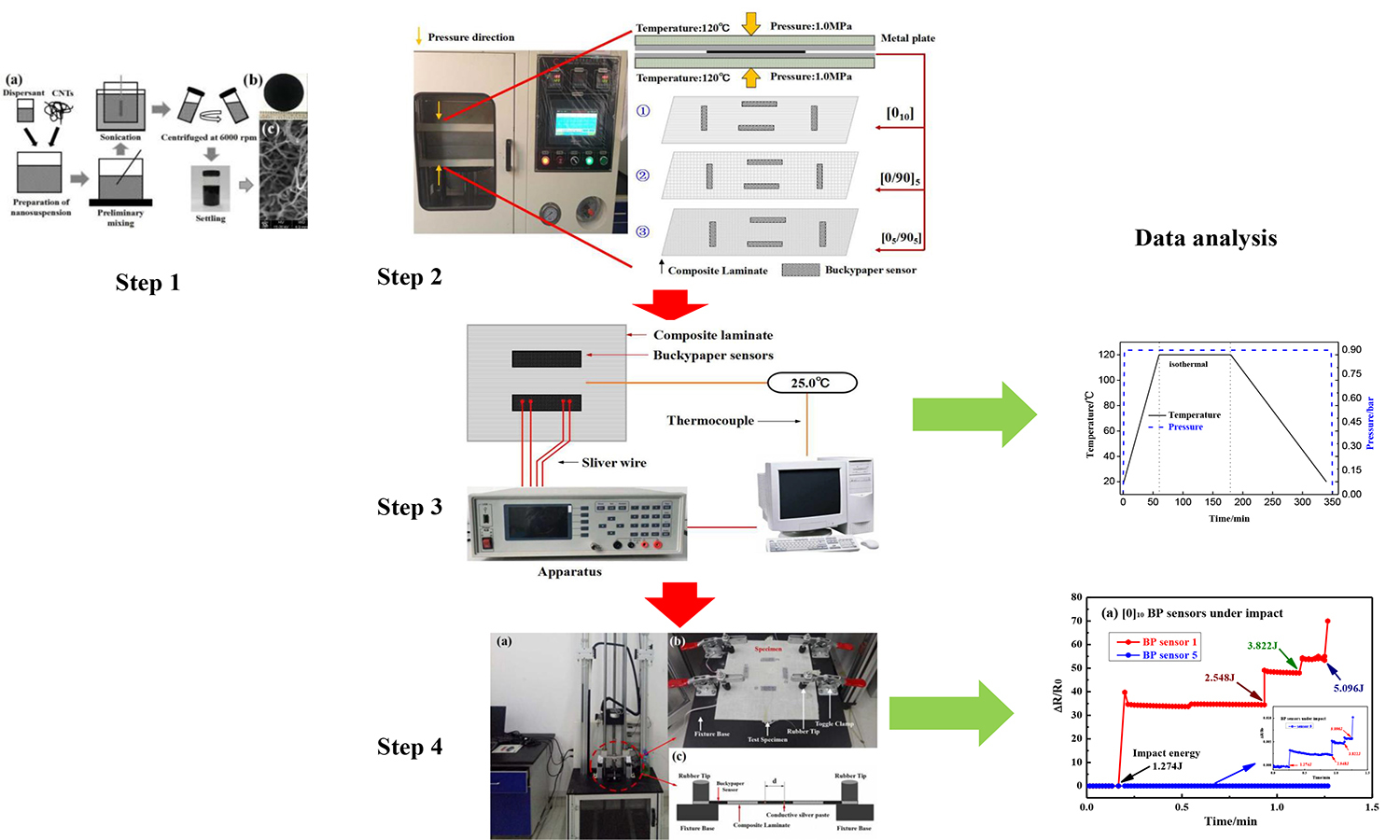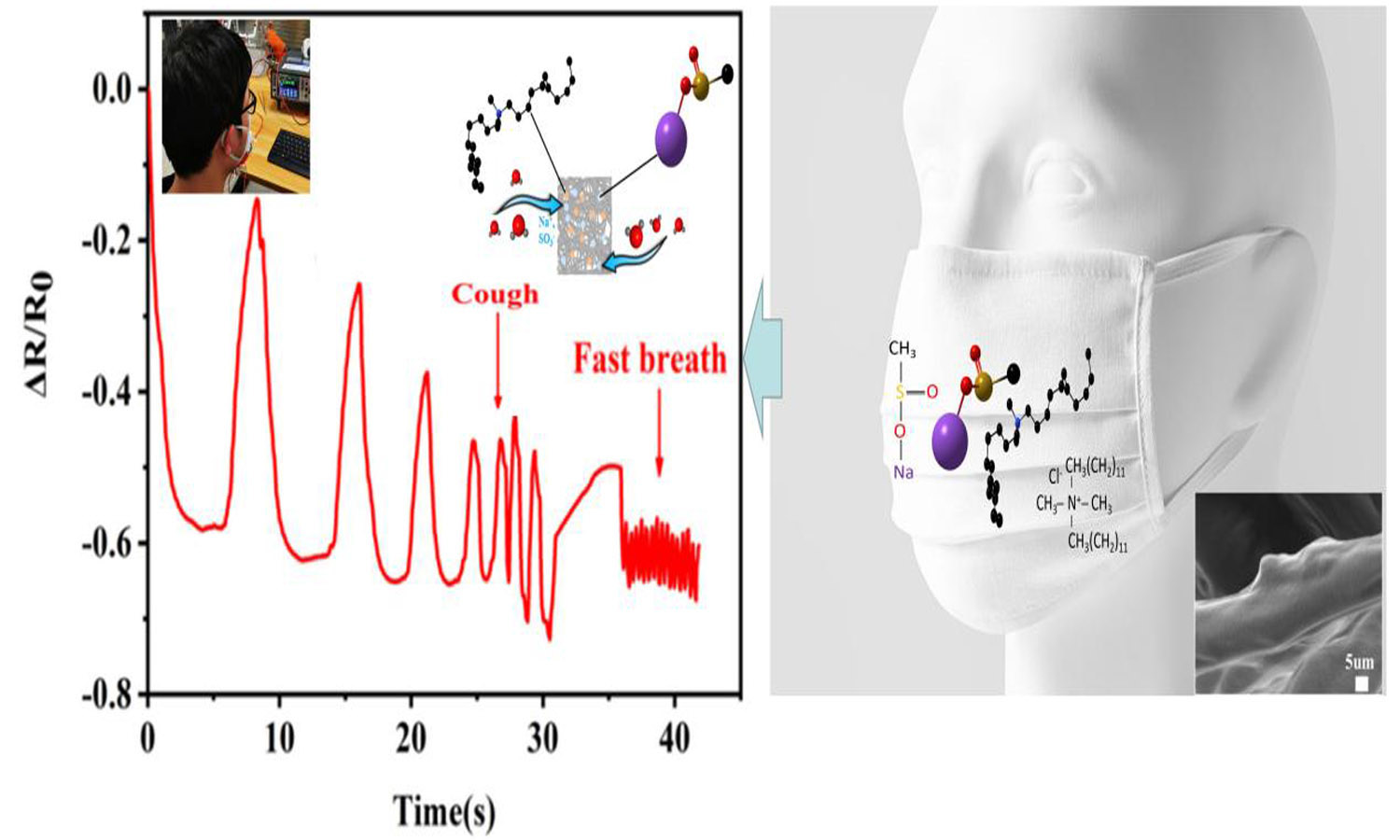Online in-situ monitoring of curing and impact damage of composite structure with embedded CNT sensors
Kai Du, Qiang Ben, Xiaoqiang Wang
Vol. 19., No.8., Pages 796-808, 2025
DOI: 10.3144/expresspolymlett.2025.61
DOI: 10.3144/expresspolymlett.2025.61
GRAPHICAL ABSTRACT

ABSTRACT
The main purpose of structural health monitoring (SHM) is to detect damage at its earliest possible stage to prevent severe deterioration and reduce subsequent repair costs. Carbon nanotubes (CNTs) buckypaper (BP) was embedded into different cross-ply glass fibre composites to monitor the curing process and impact damage as an in situ sensor in this research. BP sensor can capture the four stages of the curing process, the gel point of the resin and residual stresses of the composite structure can be achieved by analysing the change of the resistance curve. Numerical and experimental analyses were performed to predict the damage in composite structures subjected to low-velocity impact. BP sensors’ electrical resistance increases with repeated impact loading; composite structure elastic deformation and damage evolution can be identified from resistance change. Experiment results show that structure monitoring based on the BP sensors cannot only detect small, barely visible impact damage flaws and the damage evaluation of composite structures subjected to impact, but also provide a new method to monitor the curing process through the analysis of results. This work makes some constructive contributions to monitoring the manufacturing process of composites and long-term SHM to evaluate impact resistance and damage prediction of composite structures.
RELATED ARTICLES
Vishnu Kadabahalli Thammannagowda, Kariyappa Gowda Guddenahalli Shivanna, Smitha Ankanahalli Shankaregowda, Stéphane Panier, Prashantha Kalappa
Vol. 19., No.7., Pages 670-685, 2025
DOI: 10.3144/expresspolymlett.2025.51
Vol. 19., No.7., Pages 670-685, 2025
DOI: 10.3144/expresspolymlett.2025.51

Triboelectric nanogenerators (TENGs) offer a promising solution for self-powered sensor applications, but their viability depends on cost-effective and efficient designs. This study presents a simple, durable, low-cost, and biodegradable poly(butylene adipate-co-terephthalate)/AgFe2O4 (PBAT/AFO) based TENG, utilizing an innovative approach towards environmental sustainability. AgFe2O4 (AFO) nanoparticles, synthesized via combustion, were characterized using X-ray diffraction (XRD) and Fourier transform infrared (FTIR) spectroscopy. Synthesized AFO nanoparticles were then incorporated into PBAT to prepare polymer nanocomposite, with scanning electron microscopy (SEM) confirming their uniform dispersion. Electrical performance evaluations demonstrated efficient charge transfer, yielding a maximum output voltage of 49.15 V and a current of 4.9 μA under hand tapping. The PBAT/AFO-TENG successfully powered LEDs and an electronic calculator, showcasing its practical utility. Additionally, it functioned as a self-powered biomechanical sensor for human body motion detection, touch security, and touch counter for laboratory entry tracking. This work highlights the simplicity, environmental sustainability, cost-effectiveness, and versatility of PBAT/AFO-TENGs, positioning them as promising candidates for future portable electronics and sensing applications.
Adam Kasprzak
Vol. 19., No.2., Pages 192-200, 2025
DOI: 10.3144/expresspolymlett.2025.14
Vol. 19., No.2., Pages 192-200, 2025
DOI: 10.3144/expresspolymlett.2025.14

This study focuses on calibrating the linear Drucker-Prager yield criterion for polypropylene under multiaxial loading conditions, using the Arcana fixture to achieve a wide range of triaxiality states. The Drucker-Prager criterion has been adapted for polymers, composites, and metals due to its ability to reflect the influence of hydrostatic pressure on yield stress. This study employs the Arcana fixture, which allows for testing flat plate samples under various angles, thereby simulating different stress states from pure shear to biaxial tension. Additionally, uniaxial compression tests were conducted to extend the range of triaxiality. The material used in this study is Sabic 83MF10, a polypropylene polymer. Samples were prepared by injection moulding and cut to specific dimensions. Tests were performed using a universal testing machine with the Arcana fixture, and the results were analysed to determine the yield strength, pressure, and triaxiality for each sample. The results showed a linear relationship between von Mises stress and hydrostatic pressure, with a friction angle (β) of 20.65° and material cohesion (d) of 27.81. The numerical simulations in Abaqus confirmed the validity of the Drucker- Prager model, accurately reflecting the moment of yielding for the tested samples.
Ferenc Ronkay
Vol. 19., No.1., Pages 1-2, 2025
DOI: 10.3144/expresspolymlett.2025.1
Vol. 19., No.1., Pages 1-2, 2025
DOI: 10.3144/expresspolymlett.2025.1

This is an editorial article. It has no abstract.
Yunhui Wu, Chengkai Luo, Huanyu Liu, Wen Li, Jun-Wei Zha
Vol. 18., No.12., Pages 1265-1276, 2024
DOI: 10.3144/expresspolymlett.2024.94
Vol. 18., No.12., Pages 1265-1276, 2024
DOI: 10.3144/expresspolymlett.2024.94

Currently, polylactic acid (PLA) is an attractive alternative to polypropylene (PP) because of its biodegradability. This study introduces a novel modification strategy for PLA by creating a multifunctional ionization layer with ionic salts. This approach achieves humidity sensing, reliable antibacterial properties, and excellent degradability simultaneously. The modified PLA textile sensor exhibits high sensitivity to respiratory humidity (0.92 at 90% RH), with ultrafast response (0.12 s) and recovery times (0.16 s). Additionally, the textile demonstrates excellent antibacterial performance against both E. coli (99.9%) and S. aureus (99.9%) after 1 h of contact. It also shows notable biodegradability with a weight loss rate of 60.38% after 30 days. Also, the ionic salt mechanism is explained through dynamic ionization interactions attributed to the modified ionic salts, which feature both long-chain alkanes and active ions. This work presents a new method to enhance the respiratory detection and antibacterial performance of biodegradable masks.
Péter Csvila, Tibor Czigány
Vol. 18., No.10., Pages 1023-1038, 2024
DOI: 10.3144/expresspolymlett.2024.78
Vol. 18., No.10., Pages 1023-1038, 2024
DOI: 10.3144/expresspolymlett.2024.78

The article gives an overview of energy storage composites, their materials, manufacturing processes, and applications. Carbon- and metal-based nanoparticles and their relevant properties are presented. We focus on multifunctional structural supercapacitors and their components. Thus, we describe the main structural electrolytes and elements of the structural electrodes. We show that the nanoparticles significantly influence the electrochemical properties of the electrode. For example, carbon-based nanoparticles can achieve low energy density but high power density, while the opposite is true for metal-based nanoparticles. We show that when carbon- and metal-based nanoparticles are used together, a positive synergy is created between them, promoting the development of favorable electrochemical properties in the electrodes. Furthermore, we present structural supercapacitors and possible ways to introduce nanoparticles into the system. Finally, we present a summary of the progress achieved so far and the advancements expected in the future, as well as potential areas where structural supercapacitors could be used.



